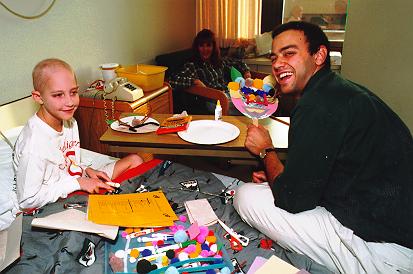
Second-year medical student Kenneth Heym works with eight-year-ild patient Jason Kelly as part of the Art for Children in Hospitals program.
Children, medical students forge lasting bonds with art
Singing, playing an instrument, drawing or painting are now part of a new elective course for first- and second-year medical students called Art for Children in Hospitals.
"The goal is to help the medical students realize how important the arts are in the care of the total child," said Bunny Burson, Cultural Enrichment coordinator and developer of the new course. "We want the students to think about how important the arts are to the children in their psycho-social behavior."
The class includes presenting an art project to medical students as well as providing discussions by faculty members on the importance of art to patients. Besides providing art activities for children in the hospital, it helps the children see doctors in a different light, Burson said.
"The children get to see that the medical students have many sides to them. It really helps to open up communication between the future doctor and the patient."
The class is offered for the first time this semester. Doctors and artists rotate every week.
"We had a child psychiatrist who talked about child development and presented an assortment of children's art work that he had accumulated during his practice.
"We've also had a doctor and a panel of parents speak to the medical students about how using the arts may help a doctor communicate better with a child, instead of just talking to parents about treatment."
Art projects include mask-making, print-making, storytelling, poetry and music. Guest artists help prepare the medical students for the project, who then go into Vanderbilt Children's Hospital to teach what they've learned to the children.
Kristi Hargrove, a part-time art instructor who specializes in modified surrealism, presented a print-making project for the class.
"In this particular project, we take objects like Legos or clothespins or strawberry crates and let the children dip them in paint and lay them on tapestry canvases. The goal is to see what kind of design or pattern could be made with these objects," Hargrove said.
"For the kids, this is a way to help them learn to create an immediate pattern and an immediate result in art. It teaches them to look at ordinary objects in a different way. And it was working with paint, which the kids love to do.
"For the medical students, this project is something that they could easily work on with the patients. It was a thrill working with the medical students, knowing I am helping them see a different approach to working with patients," Hargrove said.
The students agree.
"It's a really great way of finding a new means of communicating with children," said second-year medical student Jaime Cintado. "It's a quick and easy way of getting the children to open up and helps us learn not just how to treat illnesses, but to deal with the child, too. It's a good way of making them feel important."
The young patients are enjoying the course, too, said Burson.
"They have loved it. From the mask-making to the print-making, all our patients seem to really enjoy the activities and the chance to be with the medical students who are so interested in them.
"One patient I saw, a teenaged-girl, started out in a lot of pain from a recent surgery. But by the end of the afternoon, she and her parents had really gotten into the project and when we left, she said, 'You know, I really enjoyed it. It made the day go faster and it helped me not feel so bad.' "
Burson said the key is not only teaching an art activity, but leading the students to learn how to use it in their future practice.
Only about six schools in the nation have such a program. Students at VMS get credit for the elective course. At the end of the course, they are expected to write a paper or make an arts presentation explaining how the arts can be used with children in the hospital.
Burson said the elective course will continue through next semester when it will be re-evaluated. But Burson predicts it will continue because of the current response.
Burson said some of the financial supporters of the program would like to see it spread to other medical schools in Tennessee.
Medical students feel the same way.
"I would definitely recommend this class to other medical students," VMS II Cintado said. "Besides learning a new technique to use in our upcoming careers, it gives us an opportunity to work directly with patients, which is why we are here."













